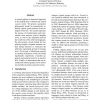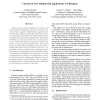7 search results - page 1 / 2 » Finding Cognate Groups Using Phylogenies |
ACL
2010
13 years 2 months ago
2010
A central problem in historical linguistics is the identification of historically related cognate words. We present a generative phylogenetic model for automatically inducing cogn...
BMCBI
2008
13 years 5 months ago
2008
Background: Modern proteomes evolved by modification of pre-existing ones. It is extremely important to comparative biology that related proteins be identified as members of the s...
ICDE
2004
IEEE
14 years 6 months ago
2004
IEEE
Frequent structure mining (FSM) aims to discover and extract patterns frequently occurring in structural data, such as trees and graphs. FSM finds many applications in bioinformat...
ALGORITHMICA
1999
13 years 4 months ago
1999
Sequence data for a group of species is often summarized by a distance matrix M where M[s, t] is the dissimilarity between the sequences of species s and t. An ordinal assertion is...
ALIFE
2004
13 years 4 months ago
2004
Phylogenetic trees group organisms by their ancestral relationships. There are a number of distinct algorithms used to reconstruct these trees from molecular sequence data, but dif...


